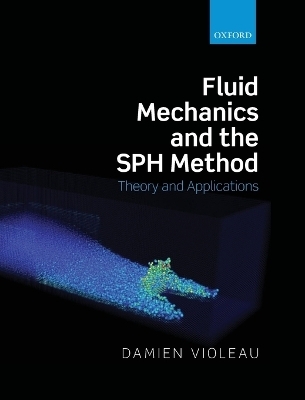
Fluid Mechanics and the SPH Method
Theory and Applications
Seiten
2012
Oxford University Press (Verlag)
978-0-19-965552-6 (ISBN)
Oxford University Press (Verlag)
978-0-19-965552-6 (ISBN)
This book presents the SPH method for fluid modelling from a theoretical and applied viewpoint. It explains the foundations of the method, from physical principles, and will help researchers, students, and engineers to understand how the method should be used and why it works well.
This book presents the SPH method (Smoothed-Particle Hydrodynamics) for fluid modelling from a theoretical and applied viewpoint. It comprises two parts that refer to each other. The first one, dealing with the fundamentals of Hydraulics, is based on the elementary principles of Lagrangian and Hamiltonian Mechanics. The specific laws governing a system of macroscopic particles are built, before large systems involving dissipative processes are explained. The continua are discussed, and a fairly exhaustive account of turbulence is given. The second part discloses the bases of the SPH Lagrangian numerical method from the continuous equations, as well as from discrete variational principles, setting out the method's specific properties of conservativity and invariance. Various numerical schemes are compared, permanently referring to the physics as dealt with in the first part. Applications to schematic instances are discussed, and, ultimately, practical applications to the dimensioning of coastal and fluvial structures are considered.
Despite the rapid growth in the SPH field, this book is the first to present the method in a comprehensive way for fluids. It should serve as a rigorous introduction to SPH and a reference for fundamental mathematical fluid dynamics. This book is intended for scientists, doctoral students, teachers, and engineers, who want to enjoy a rather unified approach to the theoretical bases of Hydraulics or who want to improve their skills using the SPH method. It will inspire the reader with a feeling of unity, answering many questions without any detrimental formalism.
This book presents the SPH method (Smoothed-Particle Hydrodynamics) for fluid modelling from a theoretical and applied viewpoint. It comprises two parts that refer to each other. The first one, dealing with the fundamentals of Hydraulics, is based on the elementary principles of Lagrangian and Hamiltonian Mechanics. The specific laws governing a system of macroscopic particles are built, before large systems involving dissipative processes are explained. The continua are discussed, and a fairly exhaustive account of turbulence is given. The second part discloses the bases of the SPH Lagrangian numerical method from the continuous equations, as well as from discrete variational principles, setting out the method's specific properties of conservativity and invariance. Various numerical schemes are compared, permanently referring to the physics as dealt with in the first part. Applications to schematic instances are discussed, and, ultimately, practical applications to the dimensioning of coastal and fluvial structures are considered.
Despite the rapid growth in the SPH field, this book is the first to present the method in a comprehensive way for fluids. It should serve as a rigorous introduction to SPH and a reference for fundamental mathematical fluid dynamics. This book is intended for scientists, doctoral students, teachers, and engineers, who want to enjoy a rather unified approach to the theoretical bases of Hydraulics or who want to improve their skills using the SPH method. It will inspire the reader with a feeling of unity, answering many questions without any detrimental formalism.
Damien Violeau graduated from Ecole des Ponts ParisTech, one of the major French engineering colleges, and currently works as 'Senior Researcher' at the National Hydraulics and Environment Laboratory of the R&D branch of EDF (Electricité de France). During 15 years of experience in engineering for waterworks and computational fluid dynamics, he has focused on the Lagrangian modelling of turbulent flows through the Smoothed Particle Hydrodynamics numerical method, SPH. He has also been acting as an organiser of the SPH international community through the working group SPHERIC (SPH European Research Interest Community).
PART I: PHYSICS OF WEAKLY COMPRESSIBLE FLUIDS; PART II: THE SPH METHOD IN HYDRAULICS
| Erscheint lt. Verlag | 3.5.2012 |
|---|---|
| Zusatzinfo | 106 b/w line illustrations, 5 b/w halftone |
| Verlagsort | Oxford |
| Sprache | englisch |
| Maße | 201 x 253 mm |
| Gewicht | 1328 g |
| Themenwelt | Naturwissenschaften ► Chemie ► Physikalische Chemie |
| Naturwissenschaften ► Geowissenschaften ► Geophysik | |
| Naturwissenschaften ► Geowissenschaften ► Hydrologie / Ozeanografie | |
| Naturwissenschaften ► Physik / Astronomie ► Festkörperphysik | |
| Naturwissenschaften ► Physik / Astronomie ► Strömungsmechanik | |
| Naturwissenschaften ► Physik / Astronomie ► Thermodynamik | |
| Technik ► Maschinenbau | |
| ISBN-10 | 0-19-965552-9 / 0199655529 |
| ISBN-13 | 978-0-19-965552-6 / 9780199655526 |
| Zustand | Neuware |
| Haben Sie eine Frage zum Produkt? |
Mehr entdecken
aus dem Bereich
aus dem Bereich
Quantenmechanik | Spektroskopie | Statistische Thermodynamik
Buch | Softcover (2024)
De Gruyter (Verlag)
CHF 83,90
Set aus Lehrbuch und Arbeitsbuch
Buch | Hardcover (2022)
Wiley-VCH (Verlag)
CHF 149,95
Thermodynamik | Kinetik | Elektrochemie
Buch | Softcover (2024)
De Gruyter (Verlag)
CHF 83,90


